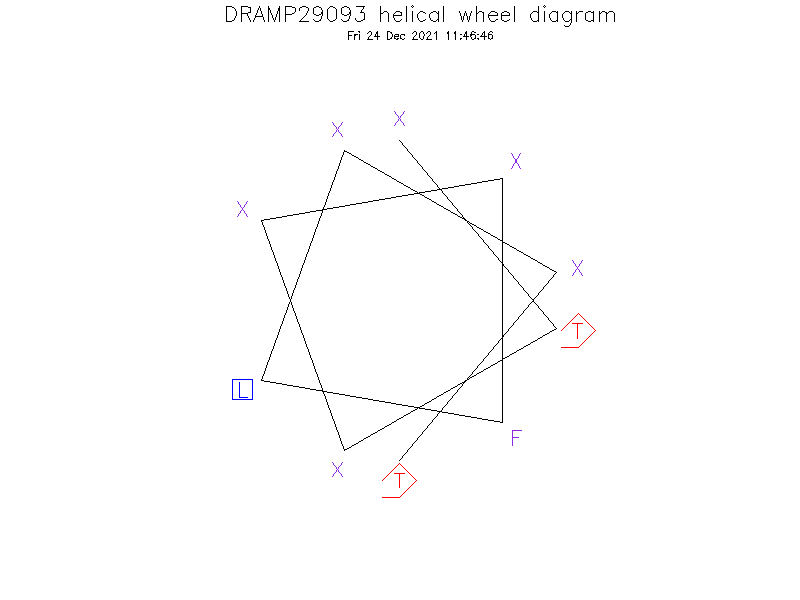General Information
-
DRAMP ID
- DRAMP29093
-
Peptide Name
- polymyxin B (a mixture of polymyxin B1 to B4)
-
Source
- Paenibacillus polymyxa
-
Family
- Belongs to the Polymyxins family
-
Gene
- N/A
-
Sequence
- XTXXXfLXXT
-
Sequence Length
- 10
-
UniProt Entry
- No entry found
-
Protein Existence
- Natural peptide(s)
Activity Information
-
Biological Activity
- Antimicrobial, Antibacterial, Anti-Gram-, Anti-inflammatory
-
Target Organism
-
- [Ref.16524407] Gram-negative bacteria: Acinetobacter spp. (MIC50 ≤ 1 μg/mL, MIC90 = 2 μg/mL), Aeromonas spp. (MIC50 ≤ 1 μg/mL, MIC90 > 8 μg/mL), Alcaligenes spp. (MIC50 = 2 μg/mL, MIC90 > 8 μg/mL), Burkholderia cepacia (MIC50 > 8 μg/mL, MIC90 > 8 μg/mL), Pseudomonas aeruginosa (MIC50 ≤ 1 μg/mL, MIC90 = 2 μg/mL), Pseudomonas spp. (non-aeruginosa) (MIC50 ≤ 1μg/mL, MIC90 = 4 μg/mL), Stenotrophomonas maltophilia (MIC50 = 1 μg/mL, MIC90 = 8 μg/mL), other non-enteric bacilli (MIC50 = 4 μg/mL, MIC90 > 4 μg/mL);
- Enterobacteriaceae: Citrobacter spp. (MIC50 ≤ 1 μg/mL, MIC90 ≤ 1 μg/mL), Enterobacter spp. (MIC50 ≤ 1 μg/mL, MIC90 > 8 μg/mL), Escherichia coli (MIC50 ≤ 1 μg/mL, MIC90 ≤ 1 μg/mL), Klebsiella spp. (MIC50 ≤ 1μg/mL, MIC90 ≤ 1μg/mL), indole-positive Proteus spp. etc. (MIC50 > 8 μg/mL, MIC90 > 8 μg/mL), Proteus mirabilis (MIC50 > 8 μg/mL, MIC90 > 8 μg/mL), Salmonella spp. (MIC50 ≤ 1 μg/mL, MIC90 = 4 μg/mL), Shigella spp. (MIC50 ≤ 1 μg/mL, MIC90 ≤ 1 μg/mL), Serratia spp. (MIC50 > 8 μg/mL, MIC90 > 8 μg/mL), other enteric bacilli (MIC50 ≤ 1 μg/mL, MIC90 = 8 μg/mL).
- NOTE: indole-positive Proteus spp. etc. includes Morganella morganii, Proteus spp., Proteus vulgaris, Providencia alcalifaciens, Providencia rettgeri, Providencia spp. and Providencia stuartii.
-
Hemolytic Activity
-
- No hemolysis information or data found in the reference(s) presented in this entry
-
Cytotoxicity
-
- Not found
-
Binding Target
- Cell membrane
Structure Information
-
Linear/Cyclic
- Cyclic
-
N-terminal Modification
- [Ref.17878146] Acylation of fatty acid (6-methyloctanoic acid for polymyxin B1, 6-methylheptanoic acid for B2, octanoic acid for B3 and heptanoic acid for B4)
-
C-terminal Modification
- [Ref.17878146] Thr10 linking to Dab5 forming a cycle.
-
Nonterminal Modifications and Unusual Amino Acids
- [Ref.17878146] ①The X in position 1, 3, 4, 5, 8 and 9 is α,γ-diaminobutyric acid (Dab). ②Dab4 links to Thr10 by amidation.
-
Stereochemistry
- [Ref.17878146] L (mixed with D-Phe7)
-
Structure
- Ordered (the structure can not be described as α-helix, β-sheet or random coil simply)
-
Structure Description
- [Ref2] According to the NMR data, there are eight structures fall into several groups, represented by the three structures. The overall structure is quite flat, with the aromatic ring oriented over the leucine methyl groups, and with a kink between residues 1−3 in the linear part of the peptide. However, differences in the ring pucker are evident, and changes in the ring pucker also affect other parts of the molecule. The peptide is interconverting among three possibilities. Changes in the ring pucker among the structures involves flipping residues 4, 8, and 9 while holding residues 6, 7, and
-
Helical Wheel Diagram
-
PDB ID
- None
-
Predicted Structure
- There is no predicted structure for DRAMP29093.
Physicochemical Information
-
Formula
Absent Amino Acids
Common Amino Acids
Mass
- 0
PI
- 0
Basic Residues
Acidic Residues
Hydrophobic Residues
Net Charge
-
Boman Index
- 0
Hydrophobicity
- 0
Aliphatic Index
- 0
Half Life
-
- Mammalian:
- Yeast:
- E.coli:
Extinction Coefficient Cystines
Absorbance 280nm
- 0
Polar Residues
DRAMP29093
Comments Information
Polymyxin B is an old antibiotic used to treat meningitis, pneumonia, sepsis, and urinary tract infections. While it is useful for many Gram-negative infections, it is not useful Gram-positive infections. It can be give by injection into a vein, muscle, or cerebrospinal fluid or inhaled. Polymyxin antibiotics are relatively neurotoxic and nephrotoxic, so are usually used only as a last resort if modern antibiotics are ineffective or are contraindicated.
Literature Information
- ·Literature 1
-
Title
- Polymyxin B for the treatment of multidrug-resistant pathogens: a critical review.
-
Pubmed ID
- 17878146
-
Reference
- J Antimicrob Chemother. 2007 Dec;60(6):1206-15. doi: 10.1093/jac/dkm357. Epub 2007 Sep 17.
-
Author
- Alexandre Prehn Zavascki, Luciano Zubaran Goldani, Jian Li, Roger L Nation
- ·Literature 2
-
Title
- Global assessment of the antimicrobial activity of polymyxin B against 54 731 clinical isolates of Gram-negative bacilli: report from the SENTRY antimicrobial surveillance programme (2001-2004).
-
Pubmed ID
- 16524407
-
Reference
- Clin Microbiol Infect. 2006 Apr;12(4):315-21. doi: 10.1111/j.1469-0691.2005.01351.x.
-
Author
- A C Gales, R N Jones, H S Sader

